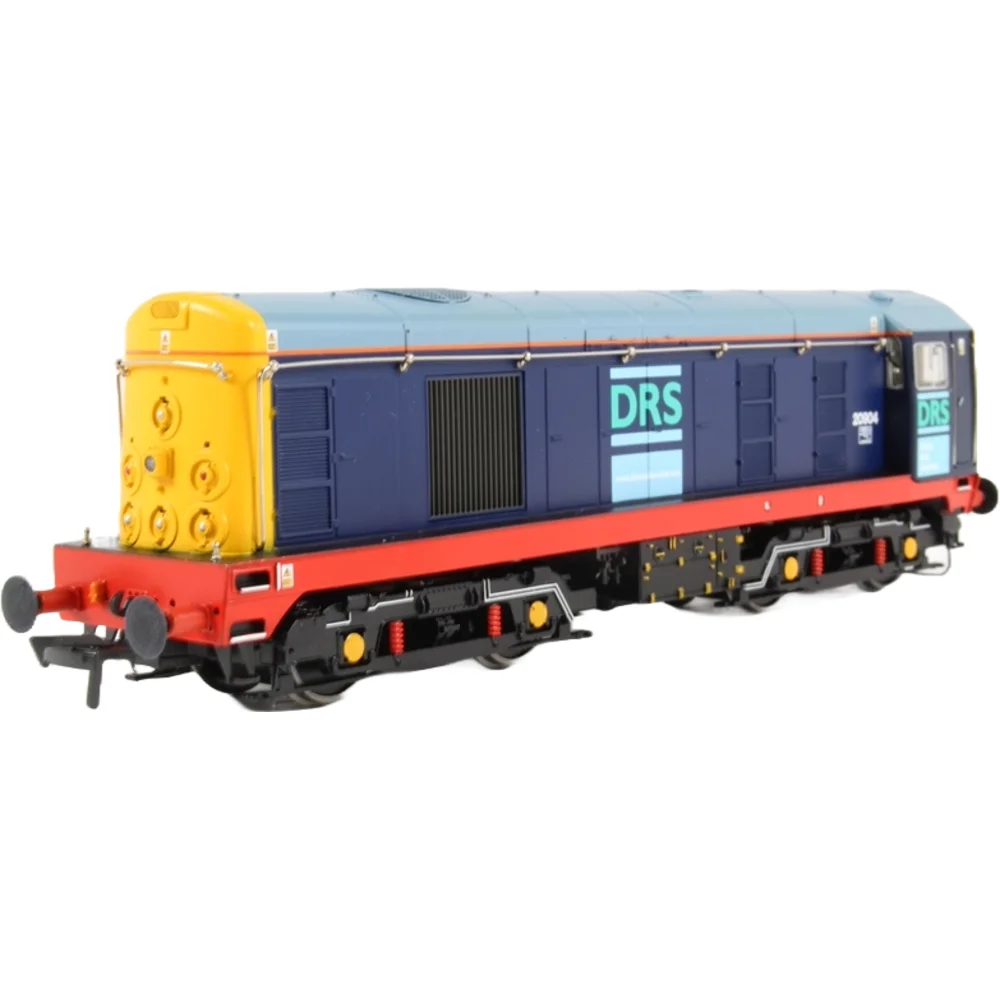Bachmann 32-025Z
British Rail Class 20 20904 Direct Rail Services Compass
Tooling
In 2004, Bachmann introduced an all-new Branchline OO-scale Class 20 model, replacing older tooling from other manufacturers. This was Bachmann’s first Class 20 in their range and represented a significant step forward in accuracy and detailing for this popular Type 1 locomotive.
Tooling Features
Scale & Construction: OO gauge (1:76); plastic body shell with separately fitted details; diecast chassis for strength and weight.
Detailing: Etched fan grills, wire handrails, lamp irons, bufferbeam detail, window wipers, sanding gear, battery boxes, footsteps, blackened wheels, and fully glazed cab windows with painted interior.
Couplings: Tension-lock couplings mounted in NEM pockets for easy replacement.
Mechanical & Electrical
Motor & Drive: Five-pole motor mounted centrally with all-wheel drive and pickups for smooth running.
Minimum Radius: Designed for second radius curves (approx. 438 mm).
Weighting: Diecast chassis provides good traction.
Lighting: Early releases had no working lights; later versions introduced directional lighting.
Assembly: Body secured to chassis with screws; additional detailing parts supplied in accessory packs.
DCC Capability
From launch, the model was DCC-ready using an 8-pin socket, allowing straightforward decoder installation. It was compatible with both analog and digital control systems.
Liveries Produced
The tooling supported a wide range of liveries, including:
- BR green (early and late crest)
- BR blue (disc and headcode box variants)
- Railfreight grey with red stripe
- Hunslet-Barclay livery
- Waterman Railways black
- Direct Rail Services (DRS) schemes
- Special and limited editions
Reviews & Commentary
The model was praised for its accurate proportions, fine detailing, and smooth running qualities. Reviewers highlighted the etched grills, separately fitted lamp irons, and realistic underframe detail. Some noted minor limitations such as the absence of lighting on early versions and occasional low-speed cogging.
Media and Social Media
Video reviews and forum discussions at the time welcomed the model as a major improvement over previous Class 20 offerings. Collectors particularly valued the variety of liveries and the inclusion of detailing packs for customization.
Other Interesting Notes
This tooling marked Bachmann’s first DCC-ready diesel locomotive in the Branchline range and set the standard for future releases. It remained in production until later retoolings in 2008 and 2021 introduced further refinements.
Class & Prototype
- Class: British Rail Class 20
- Traction: Diesel
- Transmission: Electric
- Built: 1957-1968
- Total Built: 228
The BR Class 20 (English Electric Type 1) served British railways from 1957-2025 as one of the most successful diesel designs ever built. With 228 locomotives constructed 1957-1968, these distinctive single-cab "hood units" became famous for their reliable English Electric 8SVT 1,000 hp engines, characteristic nose-to-nose paired operation, and beloved "Chopper" exhaust sound. They worked cross-London freights, Yorkshire coal trains, MGR operations, and modern nuclear flask services. Outstanding models available from Bachmann (OO), Graham Farish (N), and Heljan (O) in liveries from BR Green through DRS Blue.
No prototype found.
Operator & Livery
- Operator: Direct Rail Services
- Livery: Compass
Direct Rail Services (DRS) is Britain's premier nuclear transport and commercial rail freight operator, established in 1995 by British Nuclear Fuels Limited to handle the safe movement of nuclear materials. Now owned by the Nuclear Decommissioning Authority through Nuclear Transport Solutions, DRS has evolved into one of the UK's leading freight companies whilst maintaining its core nuclear transport mission.
Operating from major depots at Carlisle Kingmoor, Crewe Gresty Bridge, and Motherwell, DRS runs a modern fleet including cutting-edge Class 68 diesels and revolutionary Class 88 bi-mode locomotives alongside heritage Class 37s and specialist Class 20/3s. The company's distinctive blue and grey livery has become synonymous with operational excellence and technical innovation.
DRS's commercial success centres on its partnership with Tesco, operating ten dedicated rail routes carrying over 12,000 containers monthly, whilst infrastructure support services include rail head treatment, snow clearance, and rescue locomotive provision. The company's commitment to environmental leadership delivers 76% fewer CO2 emissions compared to road transport, with Class 88 locomotives achieving additional efficiency gains through dual-mode electric/diesel operation.
Key Facts:
- Founded: 1995 (30 years of operation)
- Owner: Nuclear Decommissioning Authority via Nuclear Transport Solutions
- Headquarters: Carlisle Kingmoor Depot
- Fleet: Class 20/3, 37, 66/4, 68, 88 locomotives
- Specialty: Nuclear transport, intermodal freight, infrastructure support
- Major Contract: Tesco (12,000+ containers/month across 10 routes)
- Environmental Impact: 76% CO2 reduction vs road transport
The Compass livery became the standard corporate identity for Direct Rail Services from the mid-2000s onwards. It featured a rich midnight blue body, contrasted by a sweeping turquoise and light-blue compass motif across the bodysides, symbolising nationwide coverage. Large Direct Rail Services lettering in white and turquoise was prominently displayed, alongside the company’s star-compass logo. High-visibility yellow cab ends were retained for safety, and the roof panels were finished in dark grey.
Applied across much of the DRS fleet, including Classes 37, 47, 57, 66, and 68, the Compass livery gave the operator a strong and instantly recognisable identity. Sleek and modern compared with earlier DRS schemes, it became synonymous with the company’s work on both nuclear traffic and passenger contracts such as the Cumbrian Coast services.
